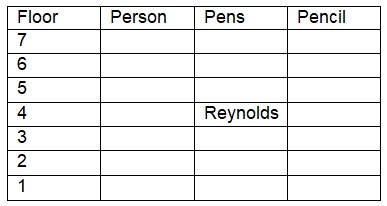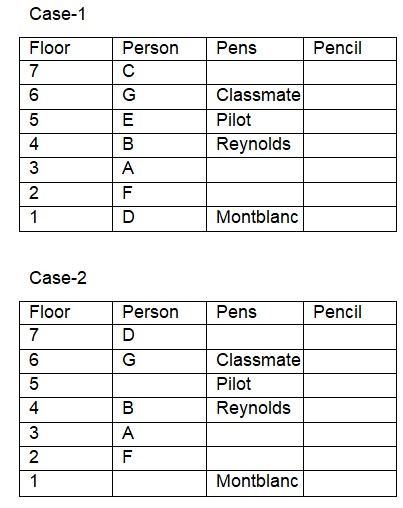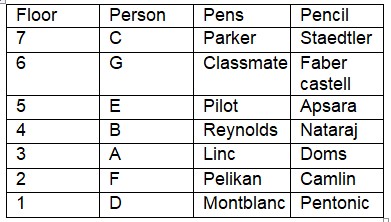Question
Who among the following likes
Montblanc? Study the following information carefully to answer the given questions: Seven Persons – A, B, C, D, E, F, and G – live on separate floors of a seven storey building, but not in the same order. The ground floor of the building is numbered 1, the floor above it 2 and so on until the topmost floor is numbered 7. Each person likes different pens – Pilot, Parker, Montblanc, Reynolds, Linc, Pelikan and Classmate, but not necessarily in the same order. Each person like different pencil namely viz – Apsara, Nataraj, Camlin, Doms, Pentonic, Faber castell and Staedtler. (i) Two persons live between the persons who like Staedtler and Nataraj. The person who likes Reynolds lives on floor numbered four. A does not live on the lowermost floor. A lives on any odd numbered floor below the one who likes Reynolds. (ii) Only two persons live between A and the person who likes Classmate. Two persons live between the persons who like Apsara and Camlin. Only one person lives between B and F. F lives on an even numbered floor and does not like Reynolds. (iii) Only three persons live between the persons who like Pilot and Montblanc respectively. The person who likes Pilot live on any floor above the B’s floor. There are two persons live between the persons who like Nataraj and Pentonic. (iv) The person who likes Pilot does not live on the topmost floor. G does not like Doms. G lives on an even numbered floor but neither immediately above nor immediately below the floor of A. C does not like Pilot or Montblanc. (V) Only two persons live between D and the one who likes Reynolds. The person who likes Staedtler lives on one of the floors above the floor numbered 5. The person who likes Linc lives on the floor immediately above the floor of the person who likes Pelikan. (vi) The person who likes Nataraj lives on one of the floors above the floor numbered 3. The person who likes Apsara lives immediately above the one who likes Nataraj. There are two persons live between the one who likes Faber castell and the one who likes Doms.Solution
From (i), (ii) and (iv), we will get the basic information as shown below:  From (i), A lives on floor no. 3. From (iv), G cannot live on floor no. 4 and 2. So, G lives on floor no. 6. From (v), we will have two cases: D lives either on floor no. 1 or 7. From (ii), F lives on floor no. 2 and B lives on floor no. 4. The one who likes Classmate lives on floor no. 6. From (iii), The one who likes Pilot and Montblanc live on floor no. 5 and 1 respectively. From (iv), C lives on floor no. 7. Case 2 will get discarded as C does not like neither Pilot nor Montblanc.
From (i), A lives on floor no. 3. From (iv), G cannot live on floor no. 4 and 2. So, G lives on floor no. 6. From (v), we will have two cases: D lives either on floor no. 1 or 7. From (ii), F lives on floor no. 2 and B lives on floor no. 4. The one who likes Classmate lives on floor no. 6. From (iii), The one who likes Pilot and Montblanc live on floor no. 5 and 1 respectively. From (iv), C lives on floor no. 7. Case 2 will get discarded as C does not like neither Pilot nor Montblanc.  From (iii) and (vi), the persons who like Nataraj lives on floor no. 4. The person who likes Apsara lives on floor no. 5. From (i), the person who likes Staedtler lives on floor no. 7. From (v), the one who likes Faber castell and Doms live on floor no. 6 and 3 respectively. Only pencil left for floor no. 2 is Camlin. From (v), The person who likes Linc and Pelikan lives on floor no. 3 and 2 respectively. Only pen left for floor no. 7 is Parker. Final arrangement as shown below:
From (iii) and (vi), the persons who like Nataraj lives on floor no. 4. The person who likes Apsara lives on floor no. 5. From (i), the person who likes Staedtler lives on floor no. 7. From (v), the one who likes Faber castell and Doms live on floor no. 6 and 3 respectively. Only pencil left for floor no. 2 is Camlin. From (v), The person who likes Linc and Pelikan lives on floor no. 3 and 2 respectively. Only pen left for floor no. 7 is Parker. Final arrangement as shown below: 
The average age of a class of 24 girls is 16 years. If 6 new girls having average age of 12 years join the class, then the average age of the class beco...
18 years ago the average age of a family of four members was 45 years. Two children were born in that span of 18 years. The present average age of the ...
Average weight of a team of 18 persons is 40 kg. When one more person joins the team, the average weight of the team increases by 4 kg. Find the weight ...
Determine the number of Girls in a school of 60 Student when you know that the average weight of all Student is 50 kgs, the average weight of boys...
The average age of A and B is 16 years. If A is to be replaced by C, the average would be 15 years. The average age of C and A is 17 years. Find the age...
- A store has 40 laptops and 60 tablets. Average cost of each laptop is Rs. 50,000 and that of each tablet is Rs. 25,000. Find the average cost (in Rs.) of a...
The average of two numbers is 2 more than the smaller number among them. If the greater number is 20% more than the smaller number, then find the sum of...
The average age of (x + 4) players in a team is 18 years. If a 38 years old coach joins the team, the average increases by 1 year. Find x% of 500.
Each question contains a statement followed by Quantity I and II. Read the information clearly and answer your questions accordingly.
Quanti...
Average age of a class of 33 students is 14 years. Average age of the class is increased by 18 months if the age of the teacher is included. Find...
Relevant for Exams:


